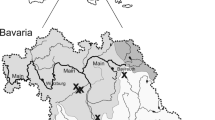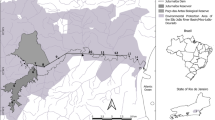Abstract
Fifteen exotic aquatic and semi aquatic Non-native Invasive Species (NIS) plus another thirteen exotic species (herbs and trees) were detected in a meandering stretch of 8.5 km and in an agricultural waterway and pools complex in Castejón (Ebro River floodplain, Navarra, NE Spain). The zebra mussel was the most ubiquitous NIS in all types of aquatic natural habitats and human infrastructures, followed by the Asian clam and red swamp crayfish in the river, both with established and abundant populations. The presence of false map terrapins is recorded for the first time in the Ebro River, and the presence of the benthic diatom throughout this stretch is confirmed, although no massive crusty filaments were found. The artificial riverside harbours with hybrid poplars could be a shelter for a small population of the beaver that was re-introduced by unapproved means in the 2000’s.
Similar content being viewed by others
References
Agúndez, D., Fluch, S., Alba, N., and Maestro, C, Introgresión genética procedente de plantaciones de híbridos en rodales naturales de Populus nigra, The III Congreso Forestal Español (Sept. 25–28, 2001, Granada), Sevilla: S.E.C.F.—Junta de Andalucía, Coria Gráfica, 2001, vol. 2, pp. 546–552.
Akatov, V.V., Akatova, T.V., Eskina, T.G., and Zagurnaya, Y.S, Relative competitiveness of adventive plant species in herbaceous communities of the Western Caucasus, Russ. J. Biol. Invasions, 2012, vol. 3, pp. 235–242.
Almodóvar, A., Nicola, G.G., Leal, S., Torralva, M., and Elvira, B, Natural hybridization with invasive bleak Alburnus alburnus threatens the survival of Iberian endemic calandino Squalius alburnoides complex and Southern Iberian chub Squalius pyrenaicus, Biol. Invasions, 2012, vol. 14, pp. 2237–2242.
Araújo, R., Reis, J., Machordom, A., Toledo, C., Madeira, M.J., Gómez, I., Velasco, J.C., Morales, J.J., Barea, J., Ondina, P., and Ayala, I, Las náyades de la Península Ibérica, Iberus, 2009, vol. 27, no. 2, pp. 7–72.
Biurrun, I, Flora y vegetación de los ríos y humedales de Navarra, Guineana, 1999, vol. 5, pp. 1–338.
Blanco, S. and Ector, L, Distribution, ecology and nuisance effects of the freshwater invasive diatom Didymosphenia geminata (Lyngbye) M. Schmidt: a literature review, Nova Hedwig., 2009, vol. 88, pp. 347–422.
Bolós, O. and Masclans, F, La vegetación de los arrozales en la región mediterranea, Collect. Bot., 1955, vol. 4, no. 3, pp. 415–434.
Cabra-Rivas, I. and Castro-Díez, P, Potential germination success of exotic and native trees coexisting in Central Spain riparian forests, Int. J. Ecol., 2016, vol. 2016. http://dx.doi.org/. doi 10.1155/2016/7614683.
Campos Prieto, J.A. and Herrera Gallastegui, M, Datos sobre flora vascular introducida en el País Vasco, An. Jard. Bot. Madrid, 1999, vol. 57, no. 2, pp. 437–441.
Darrigran, G, Potential impact of filter-feeding invaders on temperate inland freshwater environments, Biol. Invasions, 2002, vol. 4, pp. 145–156.
Dillon, R.T., Wethington, A.R., Rhett, J.M., and Smith, T.P, Populations of the European freshwater pulmonate Physa acuta are not reproductively isolated from American Physa heterostropha or Physa integra, Invertebr. Biol., 2002, vol. 121, pp. 226–234.
Domingues de Almeida, J. and Freitas, H, Acerca de algumas plantas vasculares invasoras em Portugal continental, Stud. Bot., 2002, vol. 21, pp. 27–35.
Durán, C., Lanao, M., Pérez, L., Chica, C., Anadón, A., and Touya, V, Estimación de los costes de la invasión del mejillón cebra en la cuenca del Ebro (periodo 2005–2009), Limnetica, 2012, vol. 31, no. 2, pp. 213–230.
EC—European Commission, Invasive Alien Species Factsheet, 2009. http://ec.europa.eu/environment/nature/invasivealien/indexen.htm.
EC—European Commission, The EUBiodiversity Strategy to 2020, 2011. http://ec.europa.eu/environment/nature/ biodiversity/comm2006/2020.htm.
EEA—European Environment Agency, Streamlining European biodiversity indicators 2020: building a future on lessons learnt from the SEBI 2010 process, 2012, EAA Technical Report no. 11/2012 EEA, 2012. http://www.eea.europa.eu.
Elvira, B. and Almodóvar, A., Freshwater fish introductions in Spain: facts and figures at the beginning of the 21st century, J. Fish. Biol., 2001, vol. 59, pp. 323–331.
García-Mijangos, I, Flora y vegetación de los montes Obarenes (Burgos), Guineana, 1997, vol. 3, pp. 1–437.
García-Murillo, P., Fernández-Zamudio, R., Cirujano, S., Sousa, A., and Espinar, J.M, The invasion of Doñana National Park (SW Spain) by the mosquito fern (Azolla filiculoides Lam), Limnetica, 2007, vol. 26, pp. 243–250.
Hansen, M.J. and Clevenger, A.P, The influence of disturbance and habitat on the presence of non-native plant species along transport corridors, Biol. Cons., 2005, vol. 125, pp. 249–259.
Hardion, L., Verlaque, R., Saltonstall, K., Leriche, A., and Vila, B, Origin of the invasive Arundo donax (Poaceae): a trans-Asian expedition in herbaria, Ann. Bot., 2014, vol. 114, pp. 455–462.
Hulme, P., Biological invasions in Europe: drivers, pressures, states, impacts and responses, in Biodiversity under Threat. Issues in Environmental Science and Technology, Hester, R. and Harrison, R.M., Eds., Cambridge: Cambridge Univ. Press, 2007, pp. 56–80.
Johansson, M.E., Nilsson, C., and Nilsson, E., Do rivers function as corridors for plant dispersal? J. Veg. Sci., 1996, vol. 7, pp. 593–598.
Keller, R.P., Geist, J., Jeschke, J.M., and Khün, I, Invasive species in Europe: ecology, status, and policy, Environ. Sci. Eur., 2011, vol. 23, p. 23. doi 10.1186/2190-4715-23-23
Leunda, P.M, Impacts of non-native fishes on Iberian freshwater ichthyofauna: current knowledge and gaps, Aquat. Invasions, 2010, vol. 5, no. 3, pp. 239–262.
Lowe, S., Browne, M., Boudjelas, S., and De Poorter, M., 100 of the World's worst invasive alien species: a selection from the Global Invasive Species Database, 2000. https://portals.iucn.org/library/sites/library/files/styles/ publication/public/book_covers/BC-2000-126.jpg.
Maceda-Veiga, A., de Sostoa, A., and Sánchez-Espada, S, Factors affecting the establishment of the invasive crayfish Procambarus clarkii (Crustacea, Decapoda) in the Mediterranean rivers of the northeastern Iberian Peninsula, Hydrobiologia, 2013, vol. 703, pp. 33–45.
Mariani, C., Cabrini, R., Danin, A., Piffanelli, P., Fricano, A., Gomarasca, A., Dicandilo, M., Grassi, F., and Soave, C, Origin, diffusion and reproduction of the giant reed (Arundo donax L.): a promising weedy energy crop, Ann. Appl. Biol., 2010, vol. 157, pp. 191–202.
Moore, F.K. and Jaluria, Y.Y, Thermal effects of power plants on lakes, ASME, J. Heat Transfer, 1972, vol. 94, no. 2, pp. 163–168.
Morales, J.J., Flechoso, F., Lizana, M., and Negro, A, Patrones de colonización y ecologyía de poblaciones de dos bivalvos invasores (Dreissena polymorpha Pallas, 1771 y Corbicula fluminea Müller, 1774) en un tramo lótico del Ebro medio (Castejon, Navarra), Munibe, 2013, vol. 61, pp. 47–69.
Oscoz, J, Tomás, P., and Durán, C., Review and new records of non-indigenous freshwater invertebrates in the Ebro River basin (Northeast Spain), Aquat. Invasions, 2010, vol. 5, pp. 263–284.
Patiño-Martínez, J. and Marco, A, Potencial invasor de los galápagos exóticos en el País Vasco, Munibe, 2005, vol. 56, pp. 97–112.
Pérez-Quintero, J.C, Revision of the distribution of Corbicula fluminea (Müller, 1744) in the Iberian Peninsula, Aquat. Invasions, 2008, vol. 3, pp. 355–358.
Pérez, L. and Chica, C., Actualización de la valoración económica de la invasión del mejillón cebra en la Cuenca del Ebro, Zaragoza: Confederación Hidrográfica del Ebro, Área de Calidad Ambiental, Ministerio de Medio Ambiente, Medio Rural y Marino, 2010.
Pimentel, D., Lach, L., Zuniga, R., and Morrison, D, Environmental and economic costs of nonindigenous species in the United States, BioScience, 2000, vol. 50, pp. 53–65.
Rahel, F.J. and Olden, J.D, Assessing the effects of climate change on aquatic invasive species, Conserv. Biol., 2008, vol. 22, pp. 521–533.
Rivas-Martínez, S., Díaz, T.E, Fernández-González, F., Izco, J., Loidi, J., Lousa, M., and Penas, A., Vascular plant communities of Spain and Portugal. Addenda to the syntaxonomical checklist of 2001, part I, Itinera Geobotanica, 2002, vol. 15, pp. 5–432.
Rosa, I.C., Pereira, J.L., Gomes, J., Saraiva, P.M., Gonçalves, F., and Costa, R., The Asian clam Corbicula fluminea in the European freshwater-dependent industry: a latent threat or a friendly enemy? Ecol. Econ., 2011, vol. 70, pp. 1805–1813.
Rosell, F., Bozsér, O., Collen, P., and Parker, H, Ecological impact of beavers Castor fiber and Castor canadensis and their ability to modify ecosystems, Mammal Rev., 2005, vol. 35, nos. 3–4, pp. 248–276.
Rubin, E.S., Chen, C., and Rao, A.B, Cost and performance of fossil fuel power plants with CO2 capture and storage, Energy Policy, 2007, vol. 35, no. 9, pp. 4444–4454.
Sanz-Elorza, M., Dana-Sánchez, E.D., and Sobrino, E, Atlas de las plantas aloctonas invasoras en Espana, Madrid: Dirección General para la Biodiversidad, 2004.
Savini, D., Occhipinti-Ambrogi, A., Marchini, A., Tricarico, E., Gherardi, F., Olenin, S., and Gollasch, S., The top 27 animal alien species introduced into Europe for aquaculture and related activities, J. Appl. Ichthyol., 2010, vol. 26, pp. 1–7.
Simberloff, D., Parker, I.M., and Windle, P.N, Introduced species policy, management, and future research needs, Front. Ecol. Environ., 2005, vol. 3, pp. 12–20.
Smith, S.D., Huxman, T.E., Zitzer, S.F., Charlet, T.N., Housman, D.C., Coleman, J.S., Fenstermarker, L.K., Seemann, J.R., and Nowak, R.S, Elevated CO2 increases productivity and invasive species success in an arid ecosystem, Nature, 2000, vol. 408, pp. 79–80.
Tomás, P., Oscoz, J., Durán, C., Fernández, D., and Marín, J.P, Distribution of the bloom-forming diatom Didymosphenia geminata in the Ebro River basin (Northeast Spain) in the period 2006–2009, Aquat. Invasions, 2010, vol. 5, pp. 285–289.
TOP 20: Las 20 Especies Exoticasinvasoras mas Daninas Presentes en Espana, Serie Tecnica, Leon: Grupo Especialista Invasiones Biol., 2006, no. 2.
Uribe-Echebarria, P.M. and Urrutia, P, Notas corológicas sobre la flora vascular del País Vasco y aledaños (II), Estud. Inst. Nat. Alava, 1988, vol. 3, pp. 243–255.
Ursua Sesma, M.C. and Bascones, J.C, Flora de la Ribera tudelana. I. Monocotiledóneas (Liliatae), Príncipe de Viana, Supl. Ciencias, 1986, vol. 6, pp. 41–100.
Vanden Broeck, A., Villar, M., van Bockstaele, E., and van Slycken, J, Natural hybridization between cultivated poplars and their wild relatives: evidence and consequences for native poplar populations, Ann. For. Sci., 2005, vol. 62, pp. 601–613.
Veron, G, Biogeographical history of the European beaver Castor fiber (Rodentia; Mammalia), Mammalia, 1992, vol. 56, pp. 87–108.
Vinyoles, D., Robalo, J.I., de Sostoa, A., Almodóvar, A., Elvira, B., Nicola, G.G., Fernández-Delgado, C., Santos, C.S., Doadrio, I, Sardá-Palomera, F., and Almada, V.C., Spread of the alien bleak Alburnus alburnus (Linnaeus, 1758) (Actinopterygii, Cyprinidae) in the Iberian Peninsula: the role of reservoirs, Graellsia, 2007, vol. 63, pp. 101–110.
Whitton, B.A., Ellwood, N.T.W., and Kaweca, B, Biology of the freshwater diatom Didymosphenia: a review, Hydrobiologia, 2009, vol. 630, pp. 1–37.
Zav’yalov, N.A., Al’bov, S.A., Petrosyan, V.G., Khlyap, L.A., and Goryainova, Z.I, Invasion of ecosystem engineer—the European beaver (Castor fiber)—in the Tadenka River basin (Prioksko-Terrasnyi Nature Reserve), Russ. J. Biol. Invasions, 2010, vol. 1, pp. 267–281.
Zedler, J.B. and Kercher, S, Causes and consequences of invasive plants in wetlands: opportunities, opportunists, and outcomes, Crit. Rev. Plant Sci., 2004, vol. 23, no. 5, pp. 431–452.
Author information
Authors and Affiliations
Corresponding author
Additional information
The article is published in the original.
Rights and permissions
About this article
Cite this article
Rodríguez, D., Morales, J., Flechoso, F. et al. On the distribution and general abundance of non-native species associated with the Ebro River (Castejón, Navarra, Ne Spain). Russ J Biol Invasions 8, 189–196 (2017). https://doi.org/10.1134/S2075111717020072
Received:
Published:
Issue Date:
DOI: https://doi.org/10.1134/S2075111717020072




